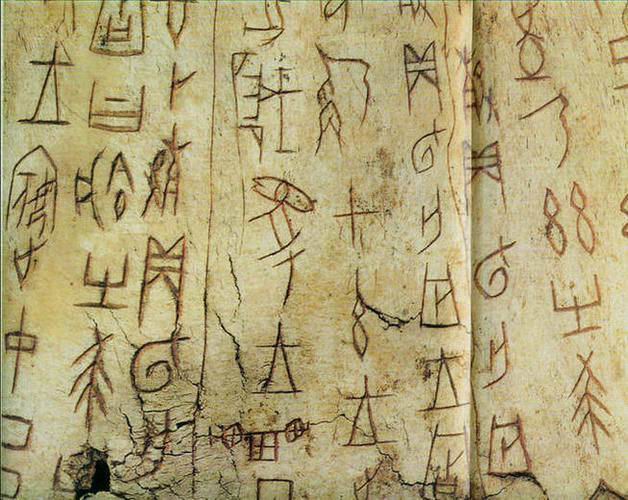Oracle-bone Inscription Carved with Sharp Knife
4 min readIn the last years of the Qing dynasty, in Xiaotun village, Anyang city, Henan province, farmers often found oracle bones when they were plowing in the fields-and some oracle bones had characters on them. In 1899, Wang Yirong first realized the value of those characters on oracle bones and started to search and collect around the place. In 1903, Liu E made rubbings from the oracle bones he collected and published a book of rubbings entitled “Hidden Turtle in the Iron Cloud”. In the author’s preface, he pointed out definitely for the first time that the characters on oracle bones were “characters carved by the Shang people with knife”.
The characters carved on tortoise shells and animal bones are known as oracle- bone inscriptions, which were used to record the augury and fete activities. They were ancien ient Chinese characters processed by necromancers and used as historica record of events happened during the 273 years from Pangeng’s moving capital to Yin to the end of the Shang dynasty.

Oracle-bone inscription, as the earliest systematic writing, already had 5,000 characters; the form and meaning of those characters were relatively fixed.
The theory of “Six Ways of Character Forming” made by late generations, namely meaning meaning denoting, event denoting, form and echoism, meaning bo pictograph, orrowir wing, meaning transferring, could all be seen in the forming and use of those characters. Meanwhile, oracle-bone inscription also had systematical grammar which might help to express people’s manner and thought fluently and accurately.
Besides, most characters in oracle-bone inscriptions are pictographs, which have complicated strokes and are more like primordial drawings, although they have different signification.
Oracle-bone inscriptions are mainly found on oracle bones used for divination. Although they were first used for primitive innocent augury, they became the symbol of civilization since they not only initiated the development of Chinese characters but also promoted Chinese calligraph as completely new field in the development of Chinese art history. Oracle-bone inscriptions, as carved script in calligraphy, are the embodiment of linear beauty.
Generally speaking, Chinese classic art always emphasizes the use of lines and calligraphy is an art blending the use of lines, form and structure to express different temperament, character and sensibility. Oracle-bone- inscriptions are just formed with lines. As the earliest carved characters, they are not born art of calligraphy. However, they have all the basic elements to become part of the art of calligraphy: strokes, structure and order. Along with the development of engraved art, they gradually attracted the attention of writers and observers, and provided a new way for posterity to express their sentiment and artistic conception. That was how calligraphy finally developed into a form of art. The oracle-bone inscriptions of the Shang dynasty had become the first group of unique engraved calligraphy works, the artistic feature of which is still influencing the style of calligraphers of our time. There are different calligraphic styles of oracle-bone inscriptions: free and unrestricted, upright and powerful, elegant and graceful, regular and integrated. bold and unconstrained, plain and simple. The styles vary because the materials and tools used in the creation of inscriptions vary. Oracle-bone inscriptions are seen on hard materials, such as bones or tortoise shells, and are the earliest type of Chinese seainvcter.

And the lines carved with knife are always fine, with strength and with cusp starting and ending strokes, though some are thick and powerful Therefore, there are thin oracle-bone inscriptions and thick oracle-bone inscriptions. Besides, the ize of size of a character depends more on its original structure and the natural size formed in actual carving. Different characters and even the same character may have different looks and sizes.
As characters are reflection of substances in nature, they are born with the aesthetic characteristic such as proportion, symmetry and can harmony which can give people different feelings with different styles. However, the different styles of oracle-bone inscriptions have obvious things in common. They all have straight and settled strokes, plain and fixed structure. Frequent use of square turning makes it plain and simple; in one character, if you other part so as to keep symmetry.
The type face also emphasizes symmetry. There are two kinds of type faces: one is to start to carve characters from the two edges of the oracle and meet in the middle later, and the other is to mark characters from the middle first and go on to both edges. Characters in both type faces are always in extremely symmetric pairs. Compared with later calligraphy oracle-bone inscriptions had two distinct characteristics, one was the complicated and pictographic structures, which wa difficult to write; the other was the simple and undecorated lines, the rhythm o which manifested the writer’s true feeling. In a word, the strokes, style, structure and overall impression of oracle-bone inscriptions demonstrated its trenchancy, random order, simplicity and roughness through the rhythm of its simple lines. Although without the mature, elegant and of simplicity had influenced calligraphy for thousands of years and was irreplaceable by any other calligraphy in its mature period.









